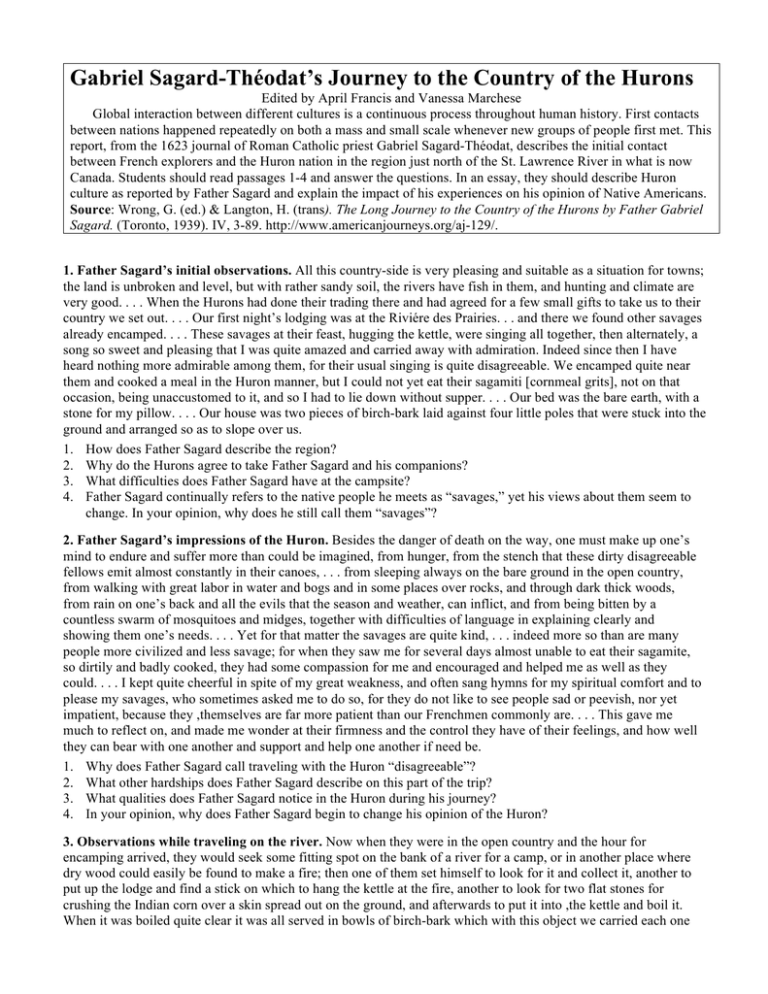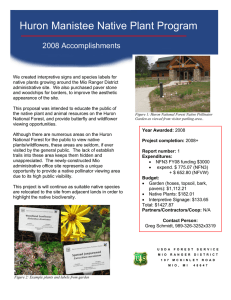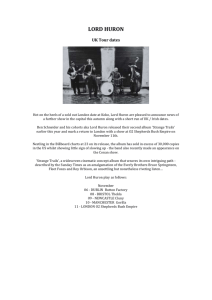Gabriel Sagard-Théodat’s Journey to the Country of the Hurons
advertisement

Gabriel Sagard-Théodat’s Journey to the Country of the Hurons Edited by April Francis and Vanessa Marchese Global interaction between different cultures is a continuous process throughout human history. First contacts between nations happened repeatedly on both a mass and small scale whenever new groups of people first met. This report, from the 1623 journal of Roman Catholic priest Gabriel Sagard-Théodat, describes the initial contact between French explorers and the Huron nation in the region just north of the St. Lawrence River in what is now Canada. Students should read passages 1-4 and answer the questions. In an essay, they should describe Huron culture as reported by Father Sagard and explain the impact of his experiences on his opinion of Native Americans. Source: Wrong, G. (ed.) & Langton, H. (trans). The Long Journey to the Country of the Hurons by Father Gabriel Sagard. (Toronto, 1939). IV, 3-89. http://www.americanjourneys.org/aj-129/. 1. Father Sagard’s initial observations. All this country-side is very pleasing and suitable as a situation for towns; the land is unbroken and level, but with rather sandy soil, the rivers have fish in them, and hunting and climate are very good. . . . When the Hurons had done their trading there and had agreed for a few small gifts to take us to their country we set out. . . . Our first night’s lodging was at the Riviére des Prairies. . . and there we found other savages already encamped. . . . These savages at their feast, hugging the kettle, were singing all together, then alternately, a song so sweet and pleasing that I was quite amazed and carried away with admiration. Indeed since then I have heard nothing more admirable among them, for their usual singing is quite disagreeable. We encamped quite near them and cooked a meal in the Huron manner, but I could not yet eat their sagamiti [cornmeal grits], not on that occasion, being unaccustomed to it, and so I had to lie down without supper. . . . Our bed was the bare earth, with a stone for my pillow. . . . Our house was two pieces of birch-bark laid against four little poles that were stuck into the ground and arranged so as to slope over us. 1. How does Father Sagard describe the region? 2. Why do the Hurons agree to take Father Sagard and his companions? 3. What difficulties does Father Sagard have at the campsite? 4. Father Sagard continually refers to the native people he meets as “savages,” yet his views about them seem to change. In your opinion, why does he still call them “savages”? 2. Father Sagard’s impressions of the Huron. Besides the danger of death on the way, one must make up one’s mind to endure and suffer more than could be imagined, from hunger, from the stench that these dirty disagreeable fellows emit almost constantly in their canoes, . . . from sleeping always on the bare ground in the open country, from walking with great labor in water and bogs and in some places over rocks, and through dark thick woods, from rain on one’s back and all the evils that the season and weather, can inflict, and from being bitten by a countless swarm of mosquitoes and midges, together with difficulties of language in explaining clearly and showing them one’s needs. . . . Yet for that matter the savages are quite kind, . . . indeed more so than are many people more civilized and less savage; for when they saw me for several days almost unable to eat their sagamite, so dirtily and badly cooked, they had some compassion for me and encouraged and helped me as well as they could. . . . I kept quite cheerful in spite of my great weakness, and often sang hymns for my spiritual comfort and to please my savages, who sometimes asked me to do so, for they do not like to see people sad or peevish, nor yet impatient, because they ,themselves are far more patient than our Frenchmen commonly are. . . . This gave me much to reflect on, and made me wonder at their firmness and the control they have of their feelings, and how well they can bear with one another and support and help one another if need be. 1. Why does Father Sagard call traveling with the Huron “disagreeable”? 2. What other hardships does Father Sagard describe on this part of the trip? 3. What qualities does Father Sagard notice in the Huron during his journey? 4. In your opinion, why does Father Sagard begin to change his opinion of the Huron? 3. Observations while traveling on the river. Now when they were in the open country and the hour for encamping arrived, they would seek some fitting spot on the bank of a river for a camp, or in another place where dry wood could easily be found to make a fire; then one of them set himself to look for it and collect it, another to put up the lodge and find a stick on which to hang the kettle at the fire, another to look for two flat stones for crushing the Indian corn over a skin spread out on the ground, and afterwards to put it into ,the kettle and boil it. When it was boiled quite clear it was all served in bowls of birch-bark which with this object we carried each one for himself, and also large spoons like small dishes, which are used for eating this broth. . . . If two groups used the same lodge each one boiled its own kettle, then all ate together, one kettle after the other, without any discussion or contention, and every man had his share of both. . . . The Indian corn which we ate on our journey they would go and fetch every second day in certain secluded places where on their way down they had hidden it in little bags made of birch-bark; for it would have been too much trouble to be always carrying, each for himself, all the corn needed for their journey. . . . The humane conduct of my host was remarkable. Although his only covering was a bear’s skin he made me share it when it was raining at night, without my asking; and in the evening he even arranged a place for me to sleep on at night, laying upon it a few small branches, and a little reed mat which it is their custom to carry for their own use on long journeys. In compassion for my difficulties and weakness he would not let me row or wield a paddle, and this was no small labor from which to relieve me, in addition to doing me the service of carrying my things and my bundle at the rapids, although he was already well laden with his own goods and with the canoe, which he carried on his shoulder . 1. According to Father Sagard, how did the Huron work together? 2. What evidence does Father Sagard provide of careful planning by the Huron? 3. How did his “host” help Father Sagard survive the difficult conditions? 4. In your opinion, why is Father Sagard so impressed by the “humane conduct” of his host? 4. Village life and customs. We stopped for some time at an Algonquin village, and hearing a great noise I was curious enough to look through a chink in a lodge to find out what it was about. There within I saw a number of men divided into two companies sitting on the ground; . . . each company had in front of them a long flat piece of wood, three or four inches broad, and every man had a stick in his hand and kept continually striking this flat piece of wood in time to the sound of the tortoise-shells and of several songs which they sang at the top of their voices. The Loki or medicine man, who was at the upper end with his large tortoise-shell in his hand, began and the others followed at the top of their voices. . . . Two women meanwhile were holding a naked child, . . . opposite to the Loki. After a little time the Loki approached the child on all fours, yelling and howling like a mad bull, then he puffed at the child round about its private parts, and after that they began their uproar and ritual again, which was finished by a feast set out at the end of the lodge. What became of the child, and whether it was cured or not, or whether some other ceremony was added I have not learned since, because we had to leave at once after having eaten and rested a little. From this tribe we went on to make our camp in a village of Andatahouats, . . . who had come to station themselves near the Freshwater sea with the purpose of bartering with the Hurons. . . .This tribe is a great nation, and most of the men are great warriors, hunters, and fishers. I saw there many women and girls making reed mats extremely well plaited, and ornamented in different colors. These they traded afterwards for other goods with the savages of different regions who came to their village.. . . . The women live very comfortably with their husbands, and they have this custom, like all other women of wandering peoples, that when they have their monthly sickness they leave their husbands, and the girl leaves her parents and other relatives, and they go to certain isolated huts away from their village; there they live and remain all the time of their sickness without any men in their company. . . . Among the Huron and other settled tribes the women and girls do not leave their house or village for such occasions, but they cook their food separately in little pots during that period and do not allow anyone to eat their meats and soups; so, that they seem to copy the Jewish women who considered themselves unclean during these periods. I have not been able to find out whence they derive this custom of separating themselves in such a manner, although I think it a very proper one. 1. What happened at the Algonquin ceremony for the sick child? 2. Why are the Andatahouats camped near the Huron village? 3. How do practices followed by Huron and Andatahouats women during their “sickness” differ? 4. Father Sagard describes the rules women follow while menstruating in detail. In your opinion, why is he so interested in these practices?
![PW Heavy Equipment Operator [Read More]](http://s3.studylib.net/store/data/006999445_1-8417856b741c62f00336b7e979d86f7e-300x300.png)




